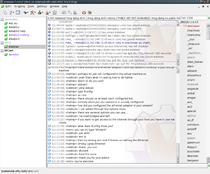KVIrc is a graphical IRC client for Linux, Unix, Mac OS and Windows. The name is an acronym of K Visual IRC in which the K stands for a dependency to KDE, which became optional from version 2.0.0.[3] The software is based on the Qt framework and its code is released under a modified GNU General Public License.[4]
 A screenshot of KVIrc | |
| Original author(s) | Szymon Stefanek (Pragma) |
|---|---|
| Developer(s) | The KVIrc Development Team |
| Stable release | 5.2.0[1] |
| Preview release | |
| Repository | |
| Written in | C++ |
| Operating system | Mac OS X, Unix-like, Windows |
| Platform | Cross-platform |
| Available in | Multilingual |
| Type | IRC client |
| License | GPL-2.0-or-later[a] |
| Website | www |
Features
editKVIrc is able to connect to several servers at the same time (optionally with SSL[5] and/or over IPv6). Unicode, ISO-8859-*, Asian and Windows-native character sets are supported. DCC is supported.[5] A special feature is the smart encoding, which allows the user to use 2 encodings at the same time; the user can send Unicode and read Unicode and CP-1252 for example.
Along with the widely supported mIRC-Codes for bold, underlined and colored fonts, KVIrc provides graphical emoticons and animated avatars. The chat interface is highly configurable and supports downloadable themes.
The channel windows can be split in two subwindows, one for chat messages and the other for commands like joins/parts/mode changes. The size of the subwindows is variable, so the user is able to hide the commands window. Every channel, query and DCC Chat is encryptable with Blowfish or AES/Rijndael.
KVIrc has its own scripting language named KVS which can be used to add complex functions to react automatically to network events.[5][6] Perl[5] and Python can be also used to a certain degree. Object-oriented programming is supported and the builtin Qt binding classes allow building additional parts of user interface. The SocketSpy feature allows developers to watch the raw communication between client and server.
Development
editSzymon Stefanek began the development of KVIrc in 1998 and released the first public version in 1999.[7] The software had a strict dependency on the KDE libraries and was available only on the Linux operating system. The interest of the free software community has grown quickly, the client was included in several linux distributions and additional developers joined the project eventually forming the informal KVIrc Development Team.
Since the KDE libraries were still in an early development stage their interface was changing very frequently and it became hard for the developers to follow them. Moreover, there was strong interest in porting KVIrc to Windows where KDE wasn't available. The strict dependency on KDELibs was then gradually weakened and officially dropped in version 2.0.0. Partial KDE integration is still available as a compile time option.
KVIrc 3.0.0 was released in 2004 with the support for Linux and Windows platforms. A preliminary Mac OS port followed in the same year.
As of January 2019, the latest stable release is 5.0.0 Aria.[8]
Distribution
editKVIrc is included in these Linux distributions: Ubuntu,[9] Debian,[10] Gentoo Linux,[11] Arch Linux,[12] OpenSUSE,[13] Mageia and Red Hat Enterprise Linux/Fedora.[14] Other linux flavors are supported via community contributed binary packages[15] and build scripts.[16] KVIrc is also available for Microsoft Windows 2000 / XP / Vista / 7,[17] Mac OS X[18] and FreeBSD.[19]
See also
editNotes
editReferences
edit- ^ "Release 5.2.0". 14 January 2024. Retrieved 19 January 2024.
- ^ "ABOUT-LICENSE". GitHub.
- ^ "Explanation for the name KVIrc". Retrieved 2010-10-11.
- ^
Szymon Stefanek. "The KVIrc License". Retrieved 2013-03-26.
This is the KVIrc Irc Client license. It is based on the GNU General Public License Version 2. [...] and [...] gives permission to link this program with Qt non-commercial edition for Windows
- ^ a b c d Piccard, Paul; H. Sachs, Marcus; Baskin, Brian (12 December 2005). Securing IM and P2P applications for the enterprise. Elsevier. p. 428. ISBN 978-1-59749-017-7.
- ^ "Introduction to the KVIrc scripting language". Retrieved 2010-10-11.
- ^ "KVIrc 0.9.0 Linux Software Map Entry". Retrieved 2010-10-11.
- ^ "2019-01-01: KVIrc 5.0.0 "Aria" Released". Retrieved 2017-12-29.
- ^ "KVIrc packages in Ubuntu". Retrieved 2010-10-11.
- ^ "KVIrc packages in Debian". Retrieved 2010-10-11.
- ^ "KVIrc ebuilds in Gentoo". Retrieved 2010-10-11.
- ^ "KVIrc packages in Arch Linux". Retrieved 2010-10-11.
- ^ "KVIrc packages in OpenSUSE". Retrieved 2010-10-11.[permanent dead link]
- ^ "KVIrc packages in rpm format for RedHat / Fedora / Mandriva / Mageia". Retrieved 2016-08-17.
- ^ "KVIrc binary packages for Slackware". Retrieved 2010-11-11.
- ^ "KVIrc build scripts for Slackware". Retrieved 2010-10-11.
- ^ "KVIrc packages for Microsoft Windows". Retrieved 2010-10-11.
- ^ "KVIrc packages for Mac OS X". Retrieved 2010-10-11.
- ^ "KVIrc FreeBSD port". Retrieved 2010-10-11.
Further reading
edit- Hertzog, Ute (2006). Linux. Pearson Deutschland GmbH. p. 785. ISBN 978-3-8272-6810-5.
- Malin, Cameron; Casey, Eoghan; M. Aquilina, James (2008). Malware Forensics: Investigating and Analyzing Malicious Code. Syngress Pub. p. 618. ISBN 978-1-59749-268-3.
- Pfaffenberger, Bryan (2001). Linux networking clearly explained. Morgan Kaufmann. p. 59. ISBN 978-0-12-533171-5.
External links
edit- Official website
- Official Russian site Archived 2021-02-25 at the Wayback Machine
- Portable KVIrc, a version of KVIrc suitable for portable storage devices